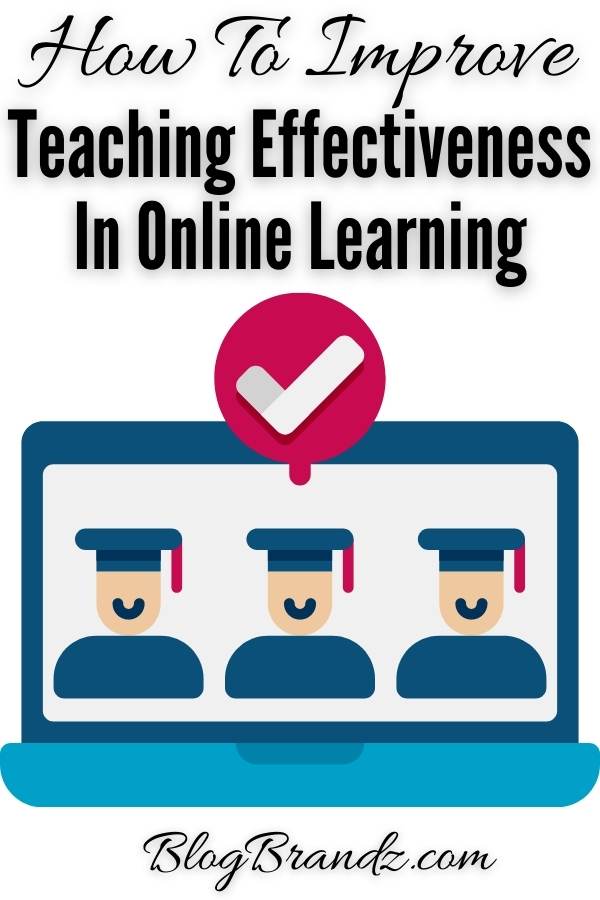
These e-training tips will help you create an engaging virtual learning environment so you can build a successful virtual learning academy.
Do you dream of starting your own online academy and offering online classes to your coaching clients or students in your own digital classroom?
Whether you plan to offer free courses or high-ticket online courses, these e-training tips will help you create an engaging virtual learning environment in your online academy.
E-training and virtual learning are a great way to provide students with access to quality online education, and a convenient way for students and professionals to access training online.
Distance learning websites have been around for a while, but ever since the pandemic disrupted education and moved it online, the e-learning and e-training industry has seen a significant spurt in growth, and it is only predicted to grow.
Here are some e-learning and e-training statistics that show this trend is here to stay, especially in the wake of the pandemic.
- E-learning increases retention rates by 25% to 60%.
- Since 2020, 98% of universities have moved classes online.
- The worldwide e-learning market is projected to be worth $325 Billion in 2025.
- IBM saved approximately $200 million after switching to e-learning.
- Corporate e-learning takes 40% to 60% less time to complete when compared to traditional learning.
But e-training and online education also come with their own set of challenges, such as keeping online learners motivated and engaged. In this article, we’ll explore different ways to motivate your online learners and boost engagement in your virtual classes.
Contents
How To Increase Student Engagement In Online Learning
Some teaching strategies to make your content more engaging and relevant include using real-world examples and case studies, incorporating multimedia content, gamification, learning styles, feedback loops, and using positive reinforcement techniques.
Other common strategies to increase student engagement in online learning include providing opportunities for students to interact with each other and the instructor on a regular basis.
This list of ways to increase student engagement in virtual learning environments includes all of these effective learning strategies and more.
#1. Sell transformation, not information
According to Danny Inny, author of Teach and Grow Rich and founder of Mirasee and the Course Builders Laboratory, an online course is a way of getting a shortcut.
In 2023, online learners are no longer looking for, or willing to pay a premium for, curated information from all over the web, nor are they just looking for the convenience of finding all the information they want in one place.
Learners today want a transformation. They want someone who can take them from Point A to Point B, or help them create a meaningful outcome.
As Danny says in the video below, people only want to pay you if you’re offering a shortcut to help them get what they want in less time, at less cost, or with less risk than it would take for them to just do it on their own.
People only want to pay you if you’re offering a shortcut to help them get what they want, in less time at less cost, or with less risk than it would take for them to just do it on their own.
Here are some resources to help you learn how to create an online course or training program:
- Jack Canfield’s Train the Trainer Online Program will give you all the techniques, training, tools, resources, and ability to transform lives like never before whether your audience is in the hundreds or thousands, in small group settings, or even one-on-one.
- The Six-Figure Course Creator program will show you how to create and sell online courses that have an impact and change the lives of others without needing to be an expert in your field or have mad video skills.
- These expert courses in instructional design, learning, and development will help you make a difference in the world of continuous learning so you can catalyze optimal organizational growth and become the expert organizations depend on.
- Here are some free and low-cost ways to validate your online course idea and assess the potential market for your course, if you think you have a great online course idea but are wondering if there’s really a market for it.
- In this free guide from Podia, you’ll learn everything you need to know about creating, launching, and selling a course, and how to create, sell, and profit from an online course.
- In this free on-demand training from Teachable, you’ll learn a proven 7-step process to create, market, and launch a profitable online course.
#2. Create a hybrid course
Online learning can include face-to-face learning, and, as Danny recommends in the video above, creating a hybrid course is the way to go today, especially if you want to sell high-ticket courses.
A hybrid learning course takes the “best of both worlds” by combining the best of face-to-face learning with the best of online learning. EverWebinar’s Hybrid Webinar feature allows you to blend the convenience of an automated presentation with the power and engagement of live chat and Q&A.
That way, your attendees won’t know they’re joining a pre-recorded event and will want to post comments and chat, just like they would in any live webinar. With evergreen webinar platforms like EverWebinar, you can deliver an automated webinar presentation over and over again without ever being present.
As part of your hybrid course model, you can use a tool like Yondo to offer virtual mentoring and live 1-to-1 video consultations as an upsell to online learners who need more one-on-one time and attention.
#3. Offer certifications
To motivate learners and boost engagement in your course, you must ensure that your online class content is relevant to their needs and interests, and offers useful and tangible benefits.
For example, offering certifications in specific skill sets, such as soft skills development programs that can help your students progress in their careers, is one way to keep them engaged throughout and promote online course completion.
The best online learning platforms and LMS software will allow you to offer certificates to those who attend your virtual classes and complete your course online.
#4. Provide multimedia materials
You can make your online course content more engaging by adding multimedia elements or increasing the level of interactivity in assignments and activities. See how you can set up quizzes for your online course with Podia.
Adding live streams, webinars, polls, and other interactive and multimedia materials will keep your students engaged and make it easier for them to understand complex concepts.
You can use mind-mapping software, like MindVisualizer, for visually capturing and organizing your thoughts and information, and export your mind maps to a wide variety of formats
Conducting polls and surveys during a webinar is a great way to simulate live interaction. If you’re a coach or a consultant, you can use interactive polls to survey your online learners and understand their needs better. If you’re a trainer or teacher, you can quiz them to test their skills and comprehension.
Try incorporating real-world examples and case studies and creating meaningful, hands-on engagement activities whenever possible. Don’t just build a course; create an experience!
“Don’t just build a course, create an experience!”
#5. Create a course community
You can create a more conducive learning environment online by including interactive and collaborative elements, maintaining regular communication with students, providing support when needed, and creating opportunities for social interaction outside of class time.
Create a sense of community among the students with a Facebook Group, forum, chat room, or messaging app where they can interact with each other.
Increase interaction and collaboration opportunities for students so they can interact with each other and with the instructor. Offer feedback and provide opportunities for students to give feedback to one another.
The Podia platform is the most creator-friendly platform on the market, with no transaction fees and an all-in-one website builder to sell your Podia courses, webinars, and downloads, and host your community.
With Podia’s free plan, you can:
- Build a free, fully customizable website
- Host a free or paid community
- Start building your email list
- Sell a digital download
- Sell coaching/consultation product
Get your free Podia plan today and access everything you need to build your online course business in one place.
#6. Encourage student-led projects
Promote feedback and collaboration among your online learners, and give them a voice by assigning group projects led by students.
Encouraging students to drive their own learning paths by creating and participating in student-led projects can promote collaboration and interaction among classmates.
When it comes to online learning, effective communication is essential. Instructors should make sure that they are available to answer questions and respond to concerns in a timely manner.
#7. Use gamification to boost engagement
Find ways to use gamification techniques to increase student engagement and motivation. Gamification is a technique that is used to make something more fun or playful by adding game elements such as points, badges, levels, or rewards.
It’s a great way to encourage online learners to engage with the content on their own terms and encourage course completion – even if it’s just for the sake of earning points or badges.
Game-based learning can be an effective way to engage students in the material, so find ways to encourage participation through gamification or other methods, such as offering unique rewards for completing the course.
How To Improve Your Online Teaching Effectiveness
Online teaching has become a popular and profitable way for educators to reach more people. Here are some ways that you can improve your online teaching effectiveness.
#1. Get teacher training & coaching certifications
Improve your presentation skills and learn effective teaching skills with train-to-teach online teacher training courses with certificates, like this transformative teacher training course for educators who want to captivate their students.
This online teaching course is for teachers and advanced students who want to learn to be effective teachers and persuasive communicators.
You can also get teaching qualifications through free online teacher training programs, professional development courses for teachers, and MOOCs from top universities and colleges.
If you want to start an online coaching business, you can become a certified coach with ICF-accredited coaching training and coach certification programs.
#2. Prepare before each online class
Make sure that you are well-prepared for each digital classroom session. This includes having all of your materials ready to go and knowing what you want to say.
Before your online class, review the material and plan how you will introduce it, and guide students through it. This will help you stay focused and organized during the class.
Also, get focused and bring positive energy to your digital classroom. You may think that your energy doesn’t matter in a virtual learning environment, but it does carry over and can infuse and energize a less-than-enthusiastic audience.
#3. Keep your course content relevant and engaging
Online classes can often be quite boring, causing learners to lose interest and become disengaged. In order to make sure that students are engaged, it is important that course creators make sure that their material is interesting and relevant.
Create engaging and interactive lessons that explain concepts simply and effectively. Incorporate classroom activities to increase student engagement.
If your online training course provides tangible benefits and specific, useful outcomes, students will be more likely to engage in it.
#4. Use multimedia effectively
Use digital tools for the classroom and classroom activities to enhance learning in your virtual classroom. Multimedia (e.g., slides, videos, audio clips) in your presentations can help keep students interested and engaged.
In this Video Production for E-Learning course, you’ll learn the skills for developing E-Learning videos to be used as educational resources that effectively support student engagement and retention.
This Video Production course will cover topics such as designing the script and storyboard and using certain filming and editing techniques to make your videos suitable for online learning.
You’ll also learn how to apply the ADDIE instructional design model to a video production project and popular learning theories and e-learning best practices to an educational video resource to support student engagement and retention.
#5. Be patient, not pushy
Two of the major obstacles to online learner engagement are being too pushy and not giving the student enough time to read and process your content.
Remember that students have different learning speeds and styles, which is why online, self-paced learning is so beneficial for some learners.
If you want them to consume all of your content, you must give them the time to do so, and provide options for self-paced online study.
#6. Pose questions frequently
Questions help students stay engaged and allow you to gauge their understanding of the material. Try to ask a question at least every few minutes when teaching online.
You can also keep online learners engaged (and awake) during your virtual classes by asking them to post comments or words in the comments section just to ensure they’re watching and participating.
#7. Be responsive to student feedback
Focus on student engagement and participation. Be sure to engage your online learners with in-class activities and discussions and help them with any questions or problems they may have.
Webinar software like EverWebinar allows you to schedule a series of reminder notifications, both via email and text, so your registrants never miss your events.
And post-webinar, you can craft emails based on their actions, such as missing your webinar, leaving early, or staying until the end.
#8. Record your online classes
Recording your online classes while you teach will help you remember what you said and allow you to go back and listen to yourself if necessary.
You can also use these recordings as classroom tools or materials for evergreen webinars, video tutorials, or podcasts you post online.
This will make it easier for students who need to review information they missed or want a second opinion on something they don’t understand.
#9. Stay organized
You can use tools to stay organized with all your classroom resources and online training materials, documents, audio, and videos in one place.
In this Instructional Design Techniques and Tools course, you’ll learn about instructional design strategies, templates, and other tools and resources to help you organize content and make a successful online, e-learning, or traditional instructor-led course that meets learning objectives.
Also, make sure you learn how to leverage the best online learning platforms to start your own virtual learning academy and sell online courses and coaching programs.
These e-training tips will help you create a conducive learning environment to ensure that your students stay engaged, understand the material you are teaching them, and complete your online classes and courses.
Online Coaching Tips & Tools
- How to become a Chief Training Officer (CTO)
- How to start an online training institute & sell online courses
- Become a coach with coaching training and certification
- Personal branding for coaches: How do I market my coaching business?
- How to create & successfully grow Facebook groups for business
- How to use PLR articles to build a coaching business & brand
- 5 secrets to building a successful coaching business
- Transforming the corporate training industry in India
- Earn money from blogs: 10 blog ideas that make money
- Best business courses to learn entrepreneur skills
© 2022 – 2024, Priya Florence Shah. All rights reserved.
Priya Florence Shah is a bestselling author and an award-winning blogger. Check out her book on emotional self-care for women. Priya writes short stories and poetry and chills with her two-legged and four-legged kids in her spare time.
Discover more from Business & Branding Tips
Subscribe to get the latest posts sent to your email.














